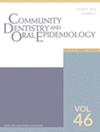To investigate the relationship between socioenvironmental sugar promotion and geographical inequalities in the prevalence of dental caries amongst 5-year-olds living across small areas within England.
Ecological data from the National Dental Epidemiology Programme (NDEP) 2018–2019, comprising information on the percentage of 5-year-olds with tooth decay (≥1 teeth that are decayed into dentine, missing due to decay, or filled), and untreated tooth decay (≥1 decayed but untreated teeth), in lower-tier local authorities (LAs) of England. These were analysed for association with a newly developed Index of Sugar-Promoting Environments Affecting Child Dental Health (ISPE-ACDH). The index quantifies sugar-promoting determinants within a child's environment and provides standardized scores for the index, and its component domains that is, neighbourhood-, school- and family-environment, with the highest scores representing the highest levels of sugar promotion in lower-tier LAs (N = 317) of England. Linear regressions, including unadjusted models separately using index and each domain, and models adjusted for domains were built for each dental outcome.
Participants lived across 272 of 317 lower-tier LAs measured within the index. The average percentage of children with tooth decay and untreated tooth decay was 22.5 (SD: 8.5) and 19.6 (SD: 8.3), respectively. The mean index score was (0.1 [SD: 1.01]). Mean domain scores were: neighbourhood (0.02 [SD: 1.03]), school (0.1 [SD: 1.0]), and family (0.1 [SD: 0.9]). Unadjusted linear regressions indicated that the LA-level percentage of children with tooth decay increased by 5.04, 3.71, 4.78 and 5.24 with increased scores of the index, and neighbourhood, school and family domains, respectively. An additional model, adjusted for domains, showed that this increased percentage predicted by neighbourhood domain attenuated to 1.37, and by family domain it increased to 6.33. Furthermore, unadjusted models indicated that the LA-level percentage of children with untreated tooth decay increased by 4.72, 3.42, 4.45 and 4.97 with increased scores of the index, and neighbourhood, school, and family domains, respectively. The model, adjusted for domains, showed that this increased percentage predicted by neighbourhood domain attenuated to 1.24 and by family domain rose to 6.47. School-domain was not significantly associated with either outcome in adjusted models.
This study reveals that socioenvironmental sugar promotion, particularly within neighbourhood- and family-environments, may contribute to geographical inequalities in dental caries in children. Further research involving data on individual-level dental outcomes and confounders is required.



